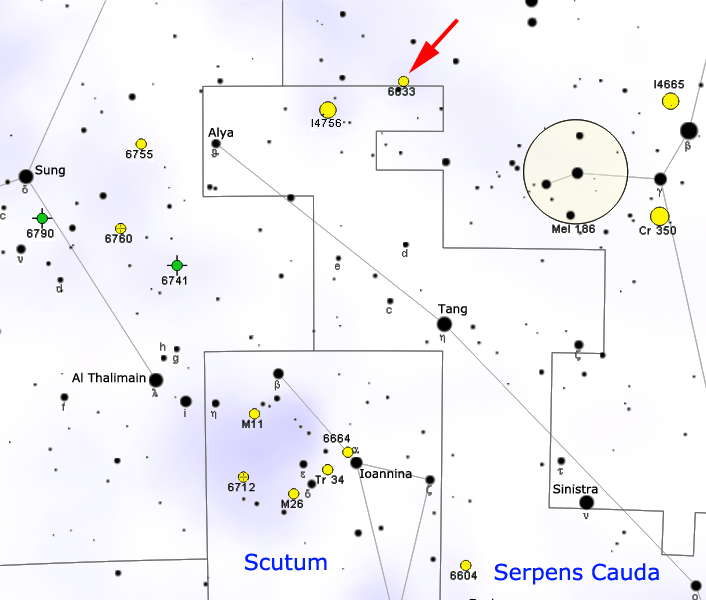NGC 6633 on:
[Wikipedia]
[Google]
[Amazon]
NGC 6633 is a large bright 
 6633
Open clusters
Ophiuchus
{{star-cluster-stub
6633
Open clusters
Ophiuchus
{{star-cluster-stub
open cluster
An open cluster is a type of star cluster made of up to a few thousand stars that were formed from the same giant molecular cloud and have roughly the same age. More than 1,100 open clusters have been discovered within the Milky Way galaxy, an ...
in the constellation Ophiuchus
Ophiuchus () is a large constellation straddling the celestial equator. Its name comes from the Ancient Greek (), meaning "serpent-bearer", and it is commonly represented as a man grasping a snake. The serpent is represented by the constella ...
. Discovered in 1745-46 by Philippe Loys de Chéseaux
Jean-Philippe Loys de Cheseaux (; 4 May 1718 – 30 November 1751) was a Swiss astronomer.
Biography
Loys de Cheseaux was born on 4 May 1718 in Lausanne, Vaud, to Paul-Etienne Loys de Cheseaux, a banneret, and Estienne-Judith de Crousaz. His ...
, it was independently rediscovered by Caroline Herschel
Caroline Lucretia Herschel (; 16 March 1750 – 9 January 1848) was a German born British astronomer, whose most significant contributions to astronomy were the discoveries of several comets, including the periodic comet 35P/Herschel–Rigolle ...
in 1783 and included in her brother William
William is a male given name of Germanic origin.Hanks, Hardcastle and Hodges, ''Oxford Dictionary of First Names'', Oxford University Press, 2nd edition, , p. 276. It became very popular in the English language after the Norman conquest of Engl ...
's catalog as H VIII.72. Bright enough to be seen with the naked eye, the cluster is considered a fine object for binoculars or small telescopes.
NGC 6633 is also known as the Tweedledum Cluster (paired with IC 4756
IC 4756 is a large bright open cluster in the constellation Serpens. Known as Graff's Cluster, it is bright enough to be seen with the naked eye and considered a fine cluster for binoculars or small telescopes.
IC 4756 is also known as the Twee ...
as Tweedledee), also as the Captain Hook Cluster. It is also designated Collinder 380 or Melotte 201. Nearly as large as the full moon, the cluster contains 38 known stars and shines with a total magnitude of 4.6; the brightest star is of mag 7.6. Its age has been estimated at 660 million years.
The cluster contains at least one chemically peculiar star - NGC 6633 48 ( BD+06 3755).
The 8th-magnitude binary star HD 169959 (NGC 6633 58) is within the line-of-sight of the open cluster but is not physically associated with it.

References
External links
* * 6633
Open clusters
Ophiuchus
{{star-cluster-stub
6633
Open clusters
Ophiuchus
{{star-cluster-stub